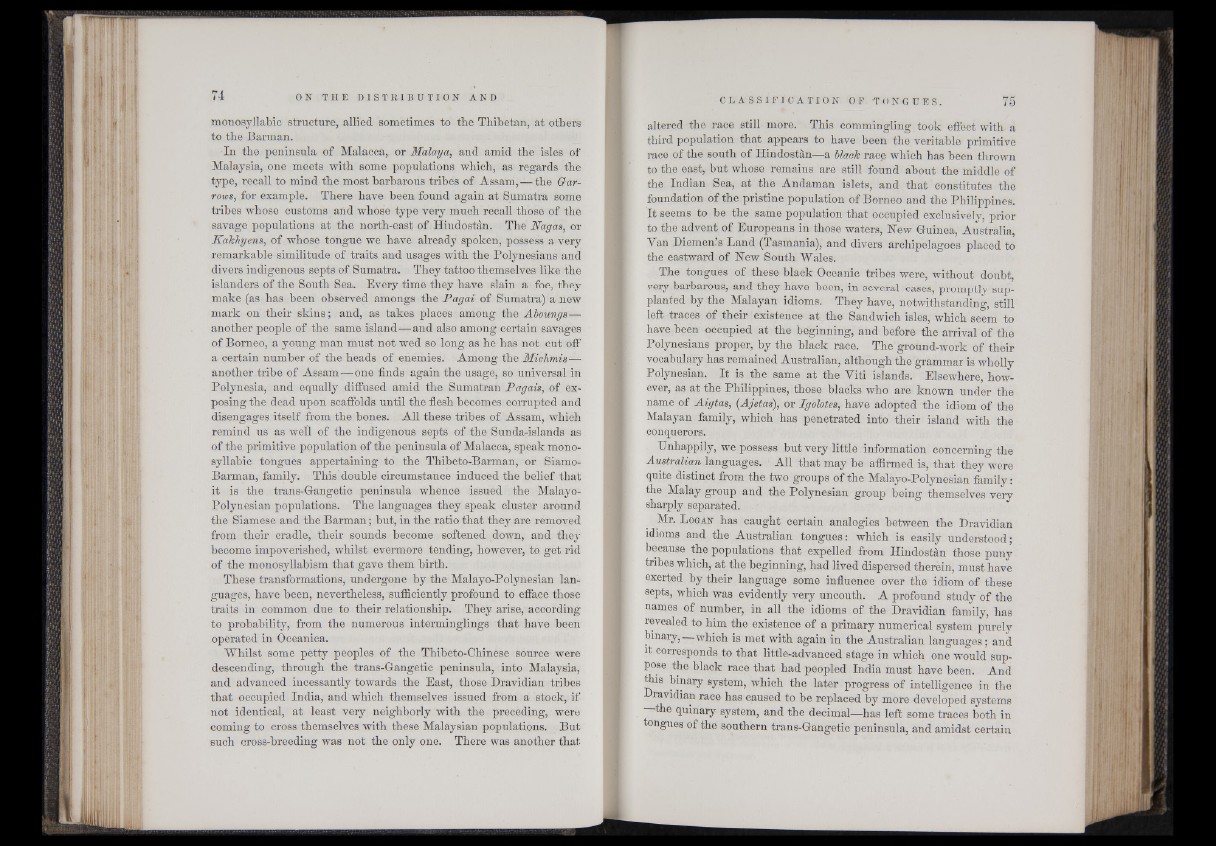
monosyllabic structure, allied sometimes to the Thibetan, at others
to the Barman.
In the peninsula of Malacca, or Malaya, and amid the isles of
Malaysia, one meets with some populations which, as regards the
type, recall to mind the most barbarous tribes of Assam, — the Gar-
rows, for example. There have been found again, at Sumatra some
tribes whose customs and whose type very much recall those of the
savage populations at the north-east of Hindostán. The Nagas, or
Kakhyens, of whose tongue we have already spoken, possess a very
remarkable similitude of traits and usages with the Polynesians and
divers indigenous septs of Sumatra. They tattoo themselves like the
islanders of the South Sea. Every time they have slain a foe, they
make (as has been observed amongs the Pagai of Sumatra) anew
mark on their skins; and, as takes places among the Aboungs—
another people of the same island—and also among certain savages
of Borneo, a young man must not wed so long as he has not cut off
a certain number of the heads of enemies. Among the Michmis—
another tribe of Assam—one finds again the usage, so universal in
Polynesia, and equally diffused amid the Sumatran Pagais, of exposing
the dead upon scaffolds until the flesh becomes corrupted and
disengages itself from the bones. All these tribes of Assam, which
remind us as well of the indigenous septs of the Sunda-islands as
of the primitive population of the peninsula of Malacca, speak monosyllabic
tongues appertaining to the Thibeto-Barman, or Siamo-
Barman, family. This double circumstance induced the belief that
it is the trans-Gangetic peninsula whence issued the Malayo-
Polynesian populations. The languages they speak cluster around
the Siamese and the Barman; but, in the.ratio that they are removed
from their cradle, their sounds become softened down, and they
become impoverished, whilst evermore tending, however, to get rid
of the monosyllabism that gave them birth.
These transformations, undergone by the Malayo-Polynesian languages,
have been, nevertheless, sufficiently profound to efface those
traits in common due to their relationship. They arise, according
to probability, from the numerous interminglings that have been
operated in Oceánica.
Whilst some petty peoples of the Thibeto-Chinese source were
descending, through the trans-Gangetic peninsula, into Malaysia,
and advanced incessantly towards the East, those Dravidian tribes
that occupied India, and which themselves issued from a stock, if
not identical, at least very neighborly with the preceding, were
coming to cross themselves with these Malaysian populations. But
such cross-breeding was not the only one. There was another that
altered the race still more. This commingling took effect with a
third population that appears to have been the veritable primitive
race of the south of Hindostán—a black racg which has been thrown
to the east, but whose remains are still found about the middle of
the Indian Sea, at the Andaman islets, and that constitutes the
foundation of the pristine population of Borneo and the Philippines.
It seems to be the same population that occupied exclusively, prior
to the advent of Europeans in those waters, Hew Guinea, Australia,
Van Diemen-’s Land (Tasmania), and divers archipelagoes placed to
the eastward of Hew South Wales.
The tongues of these black Oceanic tribes were, without doubt,
very barbarous, and they have been, in several cases, promptly supplanted
by the Malayan idioms. They have, notwithstanding, still
left traces of their existence at the Sandwich isles, which seem to
have been occupied at the beginning, and before the arrival of the
Polynesians proper, by the black race. The groünd-work of their
vocabulary has remained Australian, although the grammar is wholly
Polynesian. It is the same at the Yiti islands. Elsewhere, however,
as at the Philippines, those blacks who are known under the
name of Aigtas, (Ajetas), or Igolot.es, have adopted the idiom of the
Malayan family, which has penetrated into their island with the
conquerors.
Unhappily, we possess but very little information concerning the
Australian languages. All that may be affirmed is, that they were
quite distinct from the two groups of the Malayo-Polynesian family:
the Malay group and the Polynesian group being themselves very
sharply separated.
Mr. L ogan has caught certain analogies between the Dravidian
idioms and the Australian tongues: which is easily understood;
because the populations that expelled from Hindostán those puny
tribes which, at the beginning, had lived dispersed therein, must have
exerted by their language some influence over the idiom of these
septs, which was evidently very uncouth. A profound study of the
names of number, in all the idioms of the Dravidian family, has
revealed to him the existence of a primary numerical system purely
binary,—which is met with again in the Australian languages; and
it corresponds to that little-advanced stage in which one would suppose
the black race that had peopled India must have been. And
t is binary system, which the later progress of intelligence in the
Dravidian race has caused to be replaced by more developed systems
the quinary system, and the decimal—has left some traces both in
ongues of the southern trans-Gangetic peninsula, and amidst certain